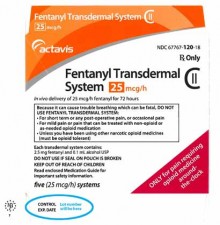 Fentanyl Pain Patches like the Actavis Pain Patch (also known as the Actavis Fentanyl Pain Patch or the Actavis Fentanyl Transdermal System) have been linked to over 120 overdose deaths, and have been subject to multiple FDA recalls & Public Health Advisories. If you or a loved one have been severely injured or killed as a result of a fentanyl pain patch like the Actavis fentanyl pain patch or any other brand fentanyl pain patch, talk to an Actavis Fentanyl Pain Patch Overdose Lawsuit Attorney at the Willis Law Firm for legal advice about filing a potential Fentanyl Pain Patch lawsuit. Please fill out the Free Case Evaluation to the right or call us toll-free at 1-800-883-9858 for immediate help.
Fentanyl Pain Patches like the Actavis Pain Patch (also known as the Actavis Fentanyl Pain Patch or the Actavis Fentanyl Transdermal System) have been linked to over 120 overdose deaths, and have been subject to multiple FDA recalls & Public Health Advisories. If you or a loved one have been severely injured or killed as a result of a fentanyl pain patch like the Actavis fentanyl pain patch or any other brand fentanyl pain patch, talk to an Actavis Fentanyl Pain Patch Overdose Lawsuit Attorney at the Willis Law Firm for legal advice about filing a potential Fentanyl Pain Patch lawsuit. Please fill out the Free Case Evaluation to the right or call us toll-free at 1-800-883-9858 for immediate help.
What is an Actavis Fentanyl Pain Patch?
Actavis fentanyl pain patches are used to manage persistent moderate to severe chronic pain. Fentanyl pain patches should only be used by people with a high tolerance to pain therapy with opioids. Actavis fentanyl pain patches and other fentanyl pain patches are available by prescription only through pharmacies, and should be used only under the supervision of a physician. Fentanyl is 100 times stronger than morphine as an analgesic. It is a mu opioid receptor agonist with high lipid solubility and a rapid onset and short duration of effects. Direct exposure to fentanyl gel may lead to serious adverse events, including respiratory depression and possible overdose, which can lead to permanent disability or death.
Actavis Fentanyl Pain Patch Recall
In February 2008, the leading fentanyl pain patch manufacturer and supplier, Actavis recalled 14 lots of its popular fentanyl pain patches in its initial Actavis fentanyl patch recall. This was the first recall. This initial voluntary recall by Actavis was conducted because it was shown that there was a possible “fold over defect” evident in examples of the Actavis Pain Patch out on the fentanyl pain patch market. This potential “fold over defect” was judged as serious enough to potentially cause a leakage of the fentanyl gel itself.
According to Actavis, the possible “fold over defect” in some lots of the Actavis Pain Patch which could lead to the potential for too much fentanyl to be released into the bloodstream via the skin. The illness that patients experienced was an overdose of fentanyl. Too much of this powerful pain medication is not only dangerous, but also could prove to be fatal.
A fentanyl overdose can lead to respiratory depression, which in turn slows breathing and the heart rate. Over long periods of time, risks including heart attacks and other negative cardiovascular events can occur, many of them fatal if not addressed and treated promptly.
In addition to the Actavis Fentanyl Pain Patch Recall, other fentanyl pain patch recalls have warned that “exposure to fentanyl hydrogel could result in an increased absorption of the opioid component, fentanyl, into the skin and bloodstream, leading to an increased drug effect, including nausea, sedation, drowsiness, and potentially life threatening complications.”
The initial Actavis Fentanyl Patch Recall was followed by a second more complete and comprehensive Actavis Fentanyl Pain Patch Recall one month later. In the second Actavis Fentanyl Pain Patch recall, all Actavis fentanyl pain patches, and generic fentanyl pain patches produced by Actavis on the market at the time, were recalled and taken off of the market. This second Actavis fentanyl pain patch recall went out to all pharmacies, wholesalers and distributors. In a statement, Actavis announced that this second, more comprehensive pain patch recall, was being made out of a desire to be “overly cautious”.
There is evidence to suggest that all Actavis fentanyl pain patches on the market at the time of the recall, even those outside the 14 lots involved in the initial Actavis fentanyl patch recall, could have all had the very same defect, and risk of fentanyl overdose with potentially life threatening results.
Lot Numbers of Actavis Pain Patch Recall
27261 (exp 05/09), 27317 (exp 05/09), 27318 (exp 06/09), 27319 (exp 06/09), 27391 (exp 06/09), 27409 (exp 06/09), 27475 (exp 07/09), 27476 (exp 06/09), 27488 (exp 06/09), 27514 (exp 07/09), 27536 (exp 07/09), 27537 (exp 08/09), 27538 (exp 08/09), 27545 (exp 07/09), covering the following strengths: 25 mcg/hr, 50 mcg/hr, 75 mcg/hr and 100 mcg/hr.
Brand Names and Dosages of Actavis Pain Patch Recall
Actavis Fentanyl Transdermal System, 25 mcg/hr. NDC 67767-120-18.
Actavis Fentanyl Transdermal System, 50 mcg/hr. NDC 67767-121-18.
Actavis Fentanyl Transdermal System, 75 mcg/hr. NDC 67767-122-18.
Actavis Fentanyl Transdermal System, 100 mcg/hr. NDC 67767-123-18
Fentanyl is a potent Schedule II opioid medication. Fentanyl pain patches that are cut or damaged in any way should not be used. Anyone who comes in contact with fentanyl gel in pain patches should thoroughly rinse exposed skin with large amounts of water only; do not use soap. Immediately safe-guard affected pain patches with damaged edges by storing them in a plastic container in a safe location, using caution not to handle the fentanyl in the fentanyl pain patches directly.
Defective fentanyl pain patches (Sold under brand name: Actavis Fentanyl Transdermal System) should be kept away from children and animals and not disposed of until you have spoken to an Actavis Pain Patch Lawsuit Lawyer or a healthcare professional. Anyone who has Actavis fentanyl pain patches should check the box or foil pouch for the expiration date and lot numbers to see if they have fentanyl pain patches that have been recalled.
The Actavis fentanyl pain patch is a generic version of the Duragesic fentanyl pain patch, which is manufactured by a subsidiary of Johnson & Johnson. Since the Duragesic patch was first introduced by Johnson & Johnson in 1994, there have been a number of reported problems with fentanyl pain patches due to manufacturing problems. At least seven different recalls of fentanyl pain patch products have been issued by Johnson & Johnson and companies manufacturing generic versions of the fentanyl pain patch, which raises questions about whether this powerful painkiller device can be made safely enough for use by the public.
The sad fact is that literally hundreds of fentanyl pain patch overdose deaths can be blamed on different versions of the fentanyl pain patch. Dozens of fentanyl patch wrongful death lawsuits have been filed against the various fentanyl pain patch manufacturers.
Actavis Fentanyl Pain Patch Class Action Lawsuit vs. Individual Actavis Pain Patch Lawsuit
There are distinct differences between an Actavis Fentanyl Pain Patch class action lawsuit and an individual Actavis Fentanyl Pain Patch lawsuit. A Fentanyl Pain Patch class action lawsuit would be one in which a large group of plaintiffs form a “class” and bring a lawsuit to court in the form of a “class action” against Actavis, the defendant.
In a class action lawsuit involving personal injury, from defective products like the Actavis Fentanyl Pain Patch, all Actavis Fentanyl Pain Patch lawsuit plaintiffs would be grouped into a single Fentanyl Pain Patch class action lawsuit, regardless of degree or severity of injury. In this type of Actavis Fentanyl Pain Patch lawsuit, plaintiffs with injuries ranging from minor ones not requiring further attention, all the way to the most severe injuries including death by fentanyl overdose, would be grouped into one single Actavis Fentanyl Pain Patch class action lawsuit. All plaintiffs in this class would share any award or settlement resulting from that Actavis Fentanyl Pain Patch class action lawsuit.
For Actavis Fentanyl Pain Patch lawsuits involving catastrophic injury or death, in most cases an individual lawsuit is more appropriate and in the plaintiff’s best interest. Actavis Fentanyl Pain Patches have been linked to severe injuries, including death from fentanyl overdose. Actavis Fentanyl Pain Patch cases such as these are better suited to an individual Actavis Fentanyl Pain Patch lawsuit because of the severity and degree of injury to the plaintiff. Each plaintiff’s case would be filed, presented and considered individually, based on its own strength, merit and degree of injury.
An individual Actavis Fentanyl Pain Patch lawsuit allows the injuries and future needs of each individual Actavis Fentanyl Pain Patch victim and their family to be considered on an individual basis when determining damages, awards and settlement amounts, and not as part of a class action lawsuit.
Actavis Fentanyl Pain Patch Overdose Lawsuit Attorney
Poorly designed and dangerous devices and medications such as the Actavis fentanyl pain patch, or any other defective fentanyl pain patch, may cause accidental overdose or other severe and devastating injuries or death.
If you or a loved one has been severely injured as a result of an Actavis fentanyl pain patch or any other fentanyl pain patch, talk to an Actavis Fentanyl Pain Patch Overdose Lawsuit Attorney at the Willis Law Firm for legal advice about a potential Fentanyl Pain Patch lawsuit. You are not alone. Join other Actavis fentanyl pain patch victims and their families in fighting for their legal rights. It may be too late to recover from some of the devastating effects of the Actavis Fentanyl Pain Patch, but an experienced pharmaceutical products liability attorney at the Willis Law Firm can assist you in legal action against the makers of the Actavis Fentanyl Pain Patch and in filing a Fentanyl Pain Patch Lawsuit.
Please fill out the Free Case Evaluation to the right or call us toll-free at 1-800-883-9858 for immediate help. Please keep in mind that certain states have a statute of limitations that limits the amount of time you have to file an Actavis Fentanyl Pain Patch lawsuit or to seek legal action. Contact our law firm immediately so we may explain the rights and options available to you and your family.

